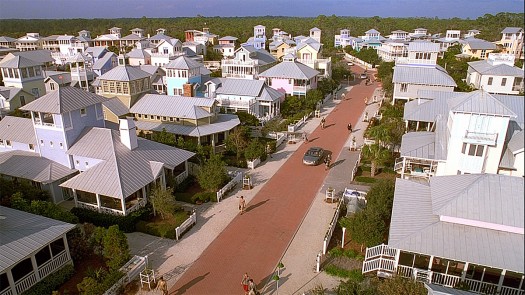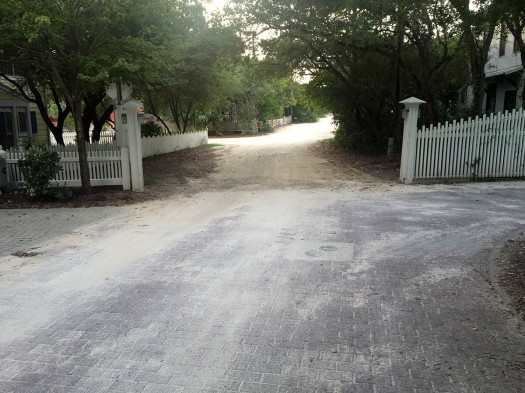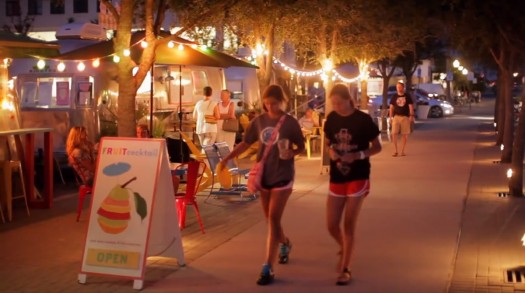A Placemaking Journal
Thoughts on Seaside at 35
If memory serves, it was twenty years ago this year that Seaside, Florida, first showed up on my radar. That’s fairly early if you use the typical southeastern beach goer as your guide but not so early if your measure is the people who actually made Seaside happen. Their window was considerably different. In fact, by the time I clued in in 1995, they’d been at the task for almost 15 years.
Over the course of the past two decades, I’ve had the immense good fortune of having met many of those people — the developer, the planners, architects who’ve designed buildings there, and people involved in the ongoing sales and marketing operation. In some cases, these meetings have been fleeting but, in others, they’ve involved walking tours around Seaside, complete with commentary on not just the community’s many successes but also its weaknesses and — dare I say it — even its failures.
That provides a terrific lens when considering one’s own thoughts on Seaside. Today I’m just coming off a return visit there where I had nothing on my plate but a week’s worth of wandering and pondering. Today’s blog presents a small collection of those thoughts.
1. It’s (long passed) time to retire the “fake place” routine
Anyone who knows anything about Seaside beyond the obvious already knows how tiresome this particular trope has proven to be — exacerbated by 1998’s release of The Truman Show, which not only put the spotlight on Seaside’s (at the time) fresh and pristine aesthetics but, perhaps worse, chronicled a man unknowingly living life on an idealized but wholly manufactured and carefully managed production set. For cynics looking for an easy pot shot, it was beyond giving candy to a baby — more like giving a hand grenade — as, in the earlier days of the New Urbanism, it resulted in all manner of distraction to a host of more substantive and important conversations that should have been taking place around how we grow and thrive in community.
From the Law of the Indies to the City of Zion to the City Beautiful and all points in between, we’ve long mapped out our future and, when circumstances allowed, grown quickly to meet it. As Ellen Dunham-Jones and June Williamson note in their book, Retrofitting Suburbia, the entire Upper West Side of Manhattan was graded and built out in a single decade. From a master land plan. Yet no one finds this justification to label it counterfeit or suspect in some way.
All through the late 90s I heard those involved with Seaside talk about the patina of age. Give it time, they said, to get a little dirt on it. To transcend its freshness with the pockmarks of weather and life. One day we’ll all wake up to find the circumstances of its birth are no longer of such consequence to the average person. And my visit last week confirmed this. Seen with fresh eyes, Seaside presents as a comfortable and relatively simple old beach town, just a bit rough around the edges. Not unlike, and I mean this as a compliment, multiple others up and down the Florida coast.
It’s worth noting that much of Seaside will qualify for historic preservation status in less than two decades. It exists today as a simple getaway town where life unfolds in entirely typical ways. Peeling paint. A broken stair. A mature landscape. That’s the stuff you see now.
2. If you think everything looks the same, you ain’t looking
Contrary to prevalent opinion, Seaside doesn’t have a very strict code. Outside some basic rules regarding materials and disposition, there’s really not much to it. Especially as it relates to style, of which the code dictates — wait for it — essentially nothing.
As a result, Seaside actually has far more stylistic diversity than people give it credit for, including healthy doses of both the modern and post-modern.
What people perceive as the result of some sort of enforced regulations actually reflects hundreds of individual design choices and the myriad influencing factors that have informed them through the decades. Is there a lot of coastal Cracker vernacular? Sure, but not because it’s required. What you’re seeing is people choosing to build in certain styles for reasons that reflect their own taste. But from house to house, the variations are actually near endless.
Another interesting thing you’ll note is that, as you move from east to west along 30A, the houses in Seaside tend to get bigger. That’s the result of sales and development phases that went street by street. Each new street reflected pricing rooted in demand at that particular moment so, as the years passed and demand grew, land became increasingly expensive and the size and amenity of each respective home grew with it.

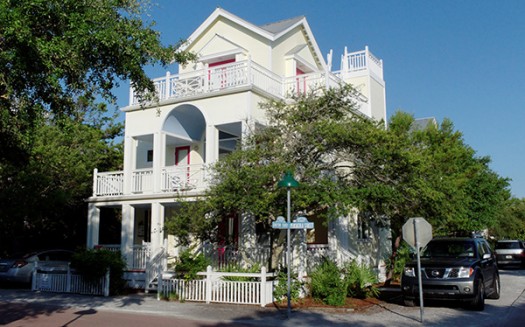
3. Idealistic ambitions don’t always jibe with human behavior
Seaside presents a wonderful array of opportunities for how people might exist communally but that’s not to be confused with how people will exist communally. Success and affluence don’t always manifest in the most endearing or inspiring of ways. One of the ways that conflict gets reflected in Seaside’s history over time is in relation to its street grid. When the town was designed in the early 80s, it extended and built upon the existing street network of adjacent Seagrove Beach. It’s presumed that the good people of Seagrove took no issue with the rationality of this approach (I’ve never seen any opposition mentioned) and, in fact, the remainder of Seaside was designed with the assumption that future development beyond its borders would further connect to and continue the same patterns.
Here’s an example of where West Grove Avenue exits Seaside and enters Seagrove.
In the late 90s, the assumption of future connectivity was tested as the St. Joe company unveiled its plans for WaterColor, the 499 acre mega-project next door. Seaside’s existing street network allowed for a couple of places where logical extensions could occur but, by then, Seaside was no longer a simple place. It had in fact become a rather fancy place. So with the prospect of extension came all the usual concerns of traffic or riffraff or compromised exclusivity or whatever and the complete connections were never made.
All that exists today are pedestrian connections. I’ll let you draw your own conclusions as to just how welcoming this particular execution comes across in practice.
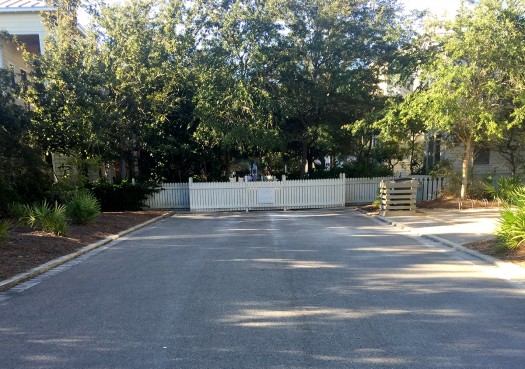
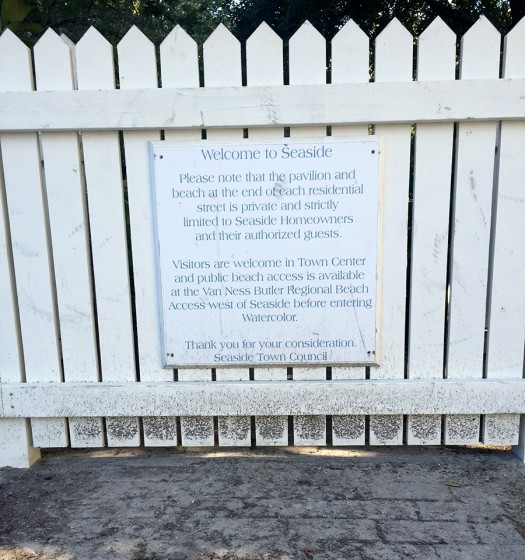
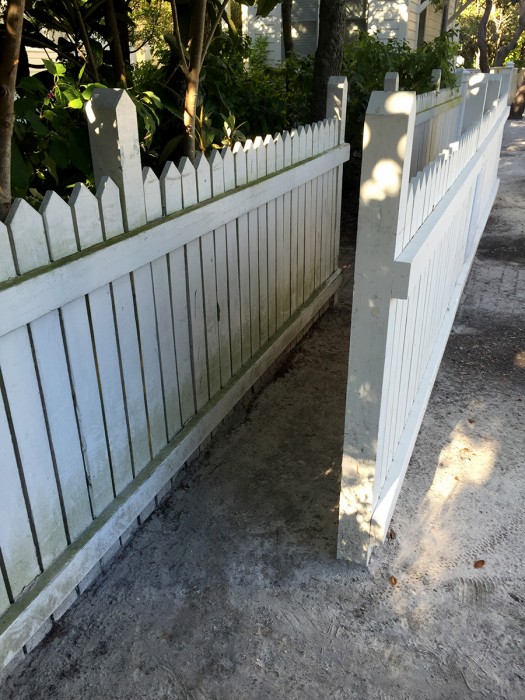
I recognize that success brings on a whole new level of problems and challenges and that property owners in Seaside surely have their own reasons for approaching connectivity as they did (and do). But as someone who admires the town’s idealistic beginnings, and the belief that good design fosters our ability to become the best version of ourselves, it’s still disappointing. No way around that.
4. Break some rules, take some chances, focus on what makes people happy
My final thought, and one that’s not particularly new or novel, is how much I love how Seaside has handled Rt. 30A, the state highway that separates the beach from the majority of town.
At the time of its design and early construction, Seaside was in the middle of nowhere in a rural county with little or no zoning. One of the upsides of this was that it provided greater freedom to do as they pleased, with an established M.O. of asking forgiveness rather than permission.
That was the case with 30A. In order to calm the street, tame the cars, facilitate human-scaled retail, and generally make the entire environment more inviting, Seaside added on-street parking the full length of the development. No matter that such parking is essentially forbidden on state highways. By the time anyone realized, the precedent was set.
As a result, Seaside was subsequently able to add sidewalks that feel safe and, thereafter, trees and modest incubator retail (Airstream food trailers in particular) that brought those sidewalks to life.
A broken rule or two, creative small-scale commerce, and a few simple things like trees and lights that make for more comfortable surroundings, and a character-free stretch of state highway is suddenly as endearing an urban block as you’re likely to find just about anywhere.
In closing
Of course there was a whole lot more that struck me over the course of the week but this is a blog post, not a long-form essay, so I’ll save it for later. For now, I suppose the theme that ties this all together is one of what’s possible when vision, tradition, creativity, adaptation and yes, time, converge in ways that allow for such careful study and consideration.
It really was a great week.
–Scott Doyon
If PlaceShakers is our soapbox, our Facebook page is where we step down, grab a drink and enjoy a little conversation. Looking for a heads-up on the latest community-building news and perspective from around the web? Click through and “Like” us and we’ll keep you in the loop.









